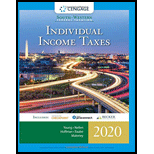
Individual Income Taxes
43rd Edition
ISBN: 9780357109731
Author: Hoffman
Publisher: CENGAGE LEARNING - CONSIGNMENT
expand_more
expand_more
format_list_bulleted
Concept explainers
Question
Chapter 19, Problem 48P
a.
To determine
Explain the effect of distribution on the gross income of Person S and tax liability if Person S invests $20,000 received through a mutual fund.
b.
To determine
Explain the effect of distribution on the gross income of Person S and tax liability if Person S invests $20,000 received in a traditional IRA within 60 days of the distribution.
c.
To determine
Explain the effect of distribution on the gross income of Person S and tax liability if Person S invests $20,000 received in a Roth IRA within 60 days of the distribution.
d.
To determine
Explain the manner in which Person S would have received better tax consequences in part (b).
Expert Solution & Answer
Want to see the full answer?
Check out a sample textbook solution
Students have asked these similar questions
General accounting
I need assistance with this financial accounting question using appropriate principles.
what was the firms 2015 operating cash flow (OCF) ??
Chapter 19 Solutions
Individual Income Taxes
Ch. 19 - Prob. 1DQCh. 19 - Prob. 2DQCh. 19 - Prob. 3DQCh. 19 - Prob. 4DQCh. 19 - Prob. 5DQCh. 19 - Prob. 6DQCh. 19 - Prob. 7DQCh. 19 - Prob. 8DQCh. 19 - Prob. 9DQCh. 19 - Prob. 10DQ
Ch. 19 - Prob. 11DQCh. 19 - Prob. 12DQCh. 19 - Prob. 13DQCh. 19 - Prob. 14CECh. 19 - Prob. 15CECh. 19 - Prob. 16CECh. 19 - Prob. 17CECh. 19 - Zack, a sole proprietor, has earned income of...Ch. 19 - Prob. 19CECh. 19 - Prob. 20CECh. 19 - Prob. 21CECh. 19 - Prob. 22CECh. 19 - Prob. 23CECh. 19 - Prob. 24CECh. 19 - Prob. 25CECh. 19 - On April 5, 2017, Gustavo was granted an NQSO for...Ch. 19 - Prob. 27PCh. 19 - Prob. 28PCh. 19 - Prob. 29PCh. 19 - Prob. 30PCh. 19 - Prob. 31PCh. 19 - Prob. 32PCh. 19 - Prob. 33PCh. 19 - Prob. 34PCh. 19 - In 2019, Magenta Corporation paid compensation of...Ch. 19 - Prob. 36PCh. 19 - Prob. 37PCh. 19 - Prob. 38PCh. 19 - Prob. 39PCh. 19 - Prob. 40PCh. 19 - Prob. 41PCh. 19 - Prob. 42PCh. 19 - Prob. 43PCh. 19 - Prob. 44PCh. 19 - Carri and Dane, ages 34 and 32, respectively, have...Ch. 19 - Prob. 46PCh. 19 - Prob. 47PCh. 19 - Prob. 48PCh. 19 - Prob. 49PCh. 19 - Prob. 50PCh. 19 - Prob. 51PCh. 19 - Prob. 52PCh. 19 - Prob. 53PCh. 19 - Prob. 54PCh. 19 - Prob. 55PCh. 19 - Prob. 56PCh. 19 - Prob. 57PCh. 19 - Prob. 1RPCh. 19 - Prob. 2RPCh. 19 - Prob. 3RPCh. 19 - Prob. 6RPCh. 19 - Prob. 8RPCh. 19 - Prob. 1CPACh. 19 - Ryan is 39 years old and works as a real estate...Ch. 19 - Prob. 3CPACh. 19 - Prob. 4CPA
Knowledge Booster
Learn more about
Need a deep-dive on the concept behind this application? Look no further. Learn more about this topic, accounting and related others by exploring similar questions and additional content below.Similar questions
- Compute variable cost per copyarrow_forwardCan you solve this general accounting problem using appropriate accounting principles?arrow_forwardMaple Co. estimated its annual manufacturing overhead at $300,000 based on 15,000 direct labor hours. The company actually used 12,000 direct labor hours during the year. How much overhead was applied to production?arrow_forward
- Morrison Industries manufactures wood polish. The standard direct materials quantity is 0.60 pounds per bottle at a cost of $2.50 per pound. The actual usage for the production of 40,000 bottles was 0.65 pounds per bottle at an actual cost of $2.45 per pound. Calculate the direct materials price variance and the direct materials quantity variance.arrow_forwardVanguard Windows manufactures skylights for residential homes. Historically, its demand has ranged from 25 to 45 skylights per day, with an average of 38. Jordan is one of the production workers, working eight hours a day, five days a week. Each order consists of one skylight, and each skylight takes 50 minutes to produce. What is the cycle time for an order? Answer pleasearrow_forwardSolve my problemarrow_forward
- what is its equity multiplier? accounting questionarrow_forwardABC Ltd. purchases machinery for $50,000, with installation charges amounting to $5,000. The company also incurs transport costs of $2,000 to bring the machinery to its location. What will be the total capitalized cost of the machinery in the books of ABC Ltd.? Helparrow_forwardVanguard Windows manufactures skylights for residential homes. Historically, its demand has ranged from 25 to 45 skylights per day, with an average of 38. Jordan is one of the production workers, working eight hours a day, five days a week. Each order consists of one skylight, and each skylight takes 50 minutes to produce. What is the cycle time for an order? Solve this financial accounting problemarrow_forward
arrow_back_ios
SEE MORE QUESTIONS
arrow_forward_ios
Recommended textbooks for you
 Individual Income TaxesAccountingISBN:9780357109731Author:HoffmanPublisher:CENGAGE LEARNING - CONSIGNMENT
Individual Income TaxesAccountingISBN:9780357109731Author:HoffmanPublisher:CENGAGE LEARNING - CONSIGNMENT






Individual Income Taxes
Accounting
ISBN:9780357109731
Author:Hoffman
Publisher:CENGAGE LEARNING - CONSIGNMENT